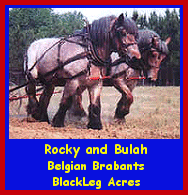Avg Weight: 1800 to 2000 lbs, with some stallions reaching 2400 lbs
Build: Thickset and stocky, it has a relatively small, well-shaped head carried on a short, thick neck, a compact, well-muscled body with massive quarters, and strong, short, heavily feathered legs.
Temperament: Has a characteristic sluggish constitution, which is noticed by its docility and obedience, but generally over-impassive temperament. Has a strong and willing disposition, a docile and phlegmatic temperament, and a strong and vigorous action.
Main use: Farming, pulling, pleasure, showing, very versatile breed.
Special abilities: In spite of this breed's size, it is very mobile and active. Matures early and is long lived.
History: In the middle ages, Belgium was famous for its heavy horses. Flemish stallions played an important role in the development of a number of breeds, including the Shire and various French draft breeds. The Belgian Heavy Draft horse dates from the foundations of 1885 at the Societe Royale "Le Cheval de Trait Belge," which was responsible for eliminating inferior strains and establishing a uniform type throughout the country. The Belgian was, at one time, exported from Belgium into the United States, where American breeders have produced the American Belgian. The American Belgian is considerably taller than it's European ancestors, standing from 17 to 18.3 hands at the withers. The Brabant is the heaviest type of the Belgians, resembling the original type in its purest form. This horse was preserved by tradition-conscious breeders who resisted all attempts to introduce fresh blood from other sources. The European and American Belgian share origins, name, and history to the mid-1800s, but apart from these areas, they have little else in common. In the 1860s, Americans preferred the Brabant type - the sorrel-colored variety in particular. But the breeders in Belgium preferred roans, and still do to this day. Today's American Belgian is lighter in color than its ancestors, most horses being chestnut with a blond mane and tail. The Stud Book for the Brabant is published by the Societe Royale pour le Cheval de Trait Belge, and dates back to 1885. Many breeds, such as the Clydesdale, are from Brabant descent.

For Breeders, Farms, and Studs of this breed, click here.
If you have a horse of this breed, and you would like to see your pictures posted here, or if you would like to advertise your business that involves this particular breed, you can also email me.
I'm not perfect, and I never claim to be! If you see anything here that you believe I am wrong about, please feel free to email me. I might not agree with you, but at least I will listen!! :0) Can you fill in any of my blanks? Do you know of information or links that you would like to share with draft animal enthusiasts that you don't see here? Am I missing anything? Let me know at Draftladyb@yahoo.com.